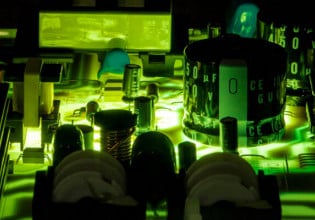PEN Inc. today announced the development of an inkjet nano-copper ink suitable for 3D printing of metallic structures. The novel 3D copper ink technology was developed at the company's Applied Nanotech Inc. subsidiary in Austin, Texas, which serves as the PEN Design Center. The Cu-IJ70 ink has particle sizes ranging from 10-200nm with an average of 150nm. The final resistivity of the cured ink is 5-7 µΩ-cm, suitable for most electronic applications.
Also today, PV Nano Cell announced the release of its new product, Sicrysâ„¢ I50TM-119, the latest in its portfolio of conductive digital inks that have the capability to significantly advance printed electronic technologies. Based on silver nanoparticles, I50TM-119 will be used in technologies including antennas, printed circuit boards, sensors, security devices and more.
Features and benefits of the new copper ink from PEN include: It can be patterned using inkjet and other additive printing technologies; It can be rapidly photosintered at room temperature; Flexible polymer substrates, such as polyimide, can be used; and processing can be conducted in ambient air environment making it easier to integrate into high-volume production lines.
"The success of the electronic 3D printing industry depends on the ability to make metallic objects or parts that have a metallic component, but suitable metallic inks and printing methods have not been readily available. The new ink enables novel sintering methods using a photo curing Xenon 2000 unit operated sequentially for each 5 micrometer thick inkjet trace in ambient air and room temperature," explained Dr. Zvi Yaniv the lead researcher.
"3D printing is the fastest growing segment in printed electronics, but without 3D metal printing its scope will be commercially limited. Our new technology has the potential to transform production in a wide range of industries, from medical devices to structural electronics," said Dr. Richard Fink, President of Applied Nanotech, Inc.
“With the advent of this new ink, we are bringing yet another high-quality product to the printed electronics market. Sicrysâ„¢ family of inks enable the implementation of digital conductive printing in industrial mass production applications and environments,†said Fernando de la Vega, Ph.D., founder and CEO of PV Nano Cell. “We are working with numerous manufacturers of various printed electronics devices, including printed circuit boards and antennas, who will be implementing our inks to help advance their technologies.â€
Sicrysâ„¢ I50TM-119, a conductive ink based on single-crystal silver nanoparticles, has been designed for inkjet printing and low temperature sintering applications, which allows for printing on flexible substrates, such as plastic, fabric or even paper. The ink, conveniently stored at room temperature, provides high silver loading, low viscosity, long shelf life, reliable jetting and good printability. Printed patterns offer a unique combination of properties, including low electrical resistivity, good adhesion to a wide range of substrates, both polymer films and Indium-tin-oxide (ITO) films, and excellent durability in humid and aqueous environments. Sicrysâ„¢ I50TM-119 shares in the properties intrinsic to the greater Sicrysâ„¢ ink family in that they all support the implementation of digital conductive printing in mass production applications.
Cost-efficient, nanometric, metal-based conductive inks that are suitable for mass production processes, such as Sicrysâ„¢ inks, are critical to the growth of the printed electronics industry. Sicrysâ„¢ inks enable the use of inkjet printing technologies, which allow for the advancement of printed electronic applications including antennas, 3D printed gadgets and wearable devices, among countless others. With Sicrysâ„¢ inks, these technologies can be made with less material and increased efficiency, reducing costs and size and increasing design flexibility. For example, the multiple antennas found in cellphones today can be printed directly onto the phone case using Sicrysâ„¢ conductive inks, reducing the size and parts necessary to produce cellphones.






